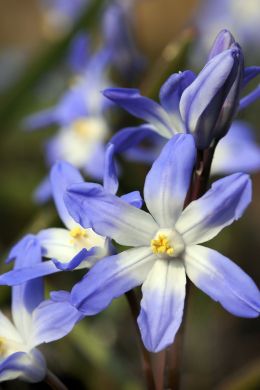Natural blanket
Glory-of-the-Snow grows in the wild in the Turkish mountains, where the colorful flowers form beautiful blankets in the snow. The botanical name Chionodoxa refers to this as well: the Greek word ‘chi?n’ means snow, and ‘doxa’ (δ?ξα) means fame or glory. This strong, but as yet relatively unknown bulbous plant deserves a place in the spotlight because it is a strong and rewarding bloomer.
Unstoppable
Glory-of-the-Snow will start to bloom from February onwards, regardless of freezing temperatures or snow. Its growth and flowering power is unstoppable, despite the cold. The small yet grand flowers consist of six petals, which are fused together. The color is usually blue, but sometimes also pink or white. They appear in great numbers, forming colored carpets in the garden.
From one to…
Glory-of-the-Snow will naturalize, how convenient is that? This does not happen via the bulbs, but through the seeds of the dead flowers. The seeds have an elaiosome attached to them (an appendage to the seed). Ants love these appendages and will take them to the place where they eat the sweet treat. The seed itself is bitter, so they leave it. New Glory-of-the-snow will sprout from this seed the following year.
Making combinations
The blue color of Glory-of-the-snow contrasts beautifully with yellow and white daffodils and small early-flowering red tulips. White and pink-colored Glory-of-the-snow goes well with yellow daffodils and lapwing flowers. A spot next to deciduous plants or shrubs is perfect. And did you know that it can also be planted in the lawn, just like crocuses and snowdrops?
Good to know about Glory-of-the-snow:
- If you want to have a colored blanket in your garden, apply the power of quantity. Plant at least fifty bulbs for one square meter.
- Glory-of-the-snow will grow almost anywhere and does not ask for much: good drainage, an open position in the sun or partial shade and a little frost.
- The bulbs need the cold of winter in order to be able to grow, but they are strong enough to withstand a dry spring and a hot summer with no trouble at all.
- Did you know that Glory-of-the-snow can withstand salty winds and therefore also thrives in a coastal location?
- Flowers often close up when there is no sunlight. But the star-shaped flowers of Glory-of-the-snow stay open, even in the absence of sunlight.





